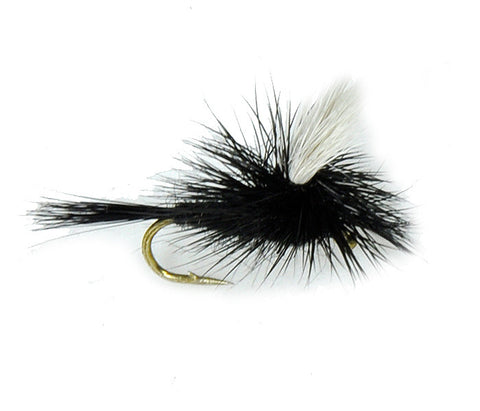Royal Coachman - Parachute

This Royal Coachman Parachute is an attractor dry fly pattern and as such can be used all season. This Royal Coachman Parachute pattern should be accompanied by the Royal Coachman dry fly and wet fly. This Royal Coachman pattern is an all season pattern. The design is credited to John Hailey and he said to have composed it in 1878 by John Haily of New York. When the trout are feeling unselective, which may be rare, or you see little action try this pattern. If they are feeding on specifics, this pattern invariably will prove ineffective. This pattern is very buoyant and are designed to be fished in rougher, faster waters were waiting trout may have less time to observe the fly as it moves by.
As the parachute pattern sits with its body in the water it looks wholly different to the fish. There are a number of instances where the insects we aim to imitate are best represented by a parachute pattern. The only time a natural insect will have its body lying flat on the water surface is during emergence. During emergence some insects are trapped by that the surface tension of the water. In addition, later in the day when there is a spinner fall, they are trapped by the surface tension. The hackle of a parachute pattern is different, it is spread laterally. This in turn changes the view from underneath the fly. It looks like an emerging insect that is spreading its legs to get that extra support and push from the shuck before it starts drying its wings. Lastly, when the female insect returns to lay her eggs wings often are caught in the surface tension and take on water. Again due her weight increasing, she will extend her legs to gain additional support. Many females are unsuccessful in flying away and this is another excellent time to use the parachute pattern as they float down with their legs extended sideways and wings trapped in the surface tension. The human benefit, we can see the post so much more clearly.
When fishing any dry fly pattern, matching the color and the size to the hatch are critical, with presentation being the finishing touch to this trinity. Often overlooked is the casting of shadow from your leader, which may lead to spooked fish. We suggest selecting a high float leader. Additional waterproofing can be given to your fly delaying it becoming waterlogged, by applying a flotant product such as Gink ®.
All flies are tied with American sourced materials including Hareline Dubbin Materials and Whiting Farm's Hackles & Capes and are tied on premium hooks.
















